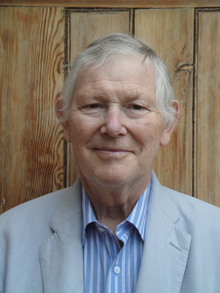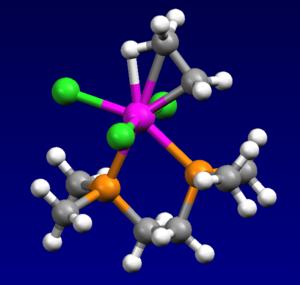Malcolm Green (chemist) facts for kids
Quick facts for kids
Malcolm Green
FRS FRSC
|
|
|---|---|
 |
|
| Born |
Malcolm Leslie Hodder Green
16 April 1936 |
| Died | 24 July 2020 (aged 84) |
| Education | Denstone College |
| Alma mater | University of London (BSc Hons) University of Cambridge (MA) University of Oxford (MA) Imperial College London (PhD) |
| Known for | Agostic interaction Covalent bond classification method Green–Davies–Mingos rules |
| Awards | Corday-Morgan Prize (1972) Tilden Prize (1982) FRS (1985) Stieglitz Lecture (1985) Davy Medal (1995) |
| Scientific career | |
| Institutions | University of Oxford University of Cambridge |
| Thesis | A study of some transitional metal hydrides and olefin complexes (1958) |
| Doctoral advisor | Geoffrey Wilkinson |
| Doctoral students | F. Geoffrey N. Cloke, Vernon C. Gibson, Gerard Parkin, Luet Lok Wong, Dermot O'Hare, Philip Mountford, Andrea Sella |
| Influences | Alan Davison, Harry Julius Emeleus |
Malcolm Leslie Hodder Green (born April 16, 1936 – died July 24, 2020) was a very important professor of Inorganic Chemistry at the University of Oxford. He was known for his amazing work in organometallic chemistry. This is a special type of chemistry that studies compounds with bonds between a metal and carbon atoms.
Contents
Early Life and Education
Malcolm Green was born in Eastleigh, Hampshire, England. He went to school at Denstone College. He earned his first degree, a Bachelor of Science, from Acton Technical College in 1956. Later, he completed his PhD from Imperial College London in 1959. His research for his PhD was guided by his supervisor, Geoffrey Wilkinson.
A Career in Chemistry
After finishing his PhD, Malcolm Green continued to work with Geoffrey Wilkinson for a year. In 1960, he moved to the University of Cambridge as an Assistant Lecturer. The next year, he became a Fellow at Corpus Christi College, Cambridge.
In 1963, he joined Balliol College, Oxford as a Fellow of Inorganic Chemistry. He also became a Demonstrator at the University of Oxford. He became a Lecturer in 1965. From 1979 to 1986, he was a Senior Research Fellow for the Royal Society in Oxford.
In 1989, he became a full Professor of Inorganic Chemistry. He also became the Head of the Inorganic Chemistry Laboratory at Oxford. He was also a Fellow of St Catherine's College, Oxford. In 2004, he became an Emeritus Research Professor, meaning he retired but still did research. He also helped start a company called Oxford Catalysts Group plc in 2006.
Professor Green also visited many other universities around the world. He was a Visiting Professor in Paris, France, and at Harvard University in the United States. He also visited the California Institute of Technology and the University of Munich in Germany.
Amazing Discoveries and Research
Malcolm Green's early work focused on metal-hydride and metal-olefin compounds. These are special chemicals that have metal atoms connected to hydrogen or carbon atoms. He studied how these compounds reacted, especially those involving molybdenum and tungsten. His work helped us understand how chemical bonds, like C-H bonds, can be changed.
He also worked on how plastics are made, especially a process called Ziegler–Natta polymerisation. He helped explain how these reactions happen. He used a method called metal vapor synthesis to make new types of metal compounds.
One of his most famous discoveries was about "agostic" bonds. These are special, close interactions between a carbon-hydrogen bond and a metal atom. He even asked a professor of Classics for a Greek word to describe this unique bond, and that's how "agostic" was chosen! This discovery helped improve how plastics are made.
Professor Green, along with Stephen G. Davies and Michael Mingos, also created a set of rules. These are called the Green–Davies–Mingos rules. They help chemists understand where certain chemical reactions will happen on molecules. One of his students, Vernon C. Gibson, also became a famous chemist.
In 1995, Green developed a new way to describe how atoms bond in complex molecules. This is called the covalent bond classification (CBC) method. It helps chemists understand and organize different types of chemical bonds.
Later in his career, he became interested in tiny carbon structures called carbon nanotubes. He found ways to "uncap" them, which means opening their ends. He also studied how to fill these tiny tubes with metals and salts.
Awards and Special Honours
Malcolm Green received many awards for his important work in chemistry. Some of his notable awards include:
- 1972: The Corday-Morgan medal from the Royal Society of Chemistry (RSC).
- 1977: Medal in Transition Metal Chemistry from the RSC.
- 1982: The Tilden Prize and Lectureship from the RSC.
- 1984: American Chemical Society Award in Inorganic Chemistry.
- 1985: Elected a Fellow of the Royal Society (FRS). This is a very high honor for scientists in the UK.
- 1985: Medal in Organometallic Chemistry from the RSC.
- 1988: Sir Edward Frankland Prize Lecturership from the RSC.
- 1995: The Davy Medal from the Royal Society.
- 1997: Medal in Organometallic Chemistry from the American Chemical Society.
- 1992: The Karl-Ziegler Prize from the Gesellschaft Deutscher Chemiker (German Chemical Society).
- Elected a Fellow of the Royal Society of Chemistry (FRSC).
- 2015: The European Prize for Organometallic Chemistry from the European Association for Chemical and Molecular Sciences.
See also
- Single-walled carbon nanohorn


